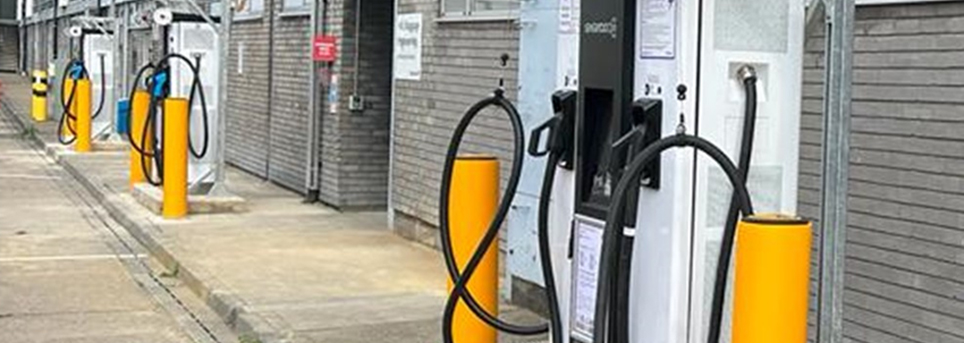The challenge
Heathrow needed to assess and understand what the future Zero Emission Vehicles (ZEV) transition plans were for the entire white fleet operating airside, which mainly consists of cars and vans.
This was phase three of the project which began in 2022. In the previous phases AiQ collaborated and worked with the largest stakeholders that operate within the airfield, including Heathrow, Virgin and others to understand what their future transition plans were in terms of going electric for their vehicle fleet. This helped inform Heathrow about what they could expect in terms of new EVs appearing airside and what the future charging demand could potentially be.
Phase three was a similar type of demand versus capacity study, but in this case specifically for the white fleet of every stakeholder operating airside. Heathrow needed to know if the charging hub that had just been installed at Terminal 2, along with the existing charging hub at Terminal 3, would give enough capacity to deal with the current demand for charging. This soon expanded into not only appraising the current T2 hub, but all future planned rapid charging hubs.
The solution
The AiQ analysts broke the project down into two different types of analysis.
Static analysis – this helped them look at demand versus capacity in terms of the absolute numbers, both in the current state and in the end state which assumed that all white fleet vehicles would go electric, and that all the planned fast charging infrastructure would be deployed. It gave an indication of how much headroom was available. However, even though this type of analysis gave a good indication, it wasn’t quite complete because it did not account for any sort of variability. It did not account for any sort of issues like for example, what happens during winter when batteries deplete faster? What happens if users don’t follow the guidelines they are meant to adhere to? What happens if the charging bases are used as parking spots? And what happens if one of the chargers gets damaged? The AiQ team needed to take all of these variables into consideration, so they developed a dynamic simulation.
Dynamic analysis – this allowed the AiQ analysts to check the sensitivity of the headroom available in various scenarios and whether there is enough headroom to facilitate any outage or bad user behaviour. This was done via a Monte Carlo simulation that was iterated 200 times, some of the inputs were varied and the simulation was given a range – a range of charging frequency and a range of charging time. Different scenarios were taken into account, which gave the team much more confidence in the results.
Initially they tested for failure scenarios, for example what happens if a charger fails? They analysed what the impact was of a charger failing at T2, at T3 and at T4. They analysed the impact of a user not charging its vehicle from 20% to 80%, as is recommended, and instead looked at what happens if users charged from 60% to 100% and also from 40% to 100%. They had a look at winter operations and again, they compared the current state with the end state.
It is important to make the point here that optimising the performance of EV vehicles like this is only possible when you have rapid charging hubs*. This is especially relevant with a space constrained airport where it is not acceptable to leave vehicles on charge for a significant length of time without having backups to facilitate the operation.
*Rapid charging usually refers to being able to charge a vehicle from 20% to 80% in less than an hour, usually about half an hour. This is something that the current stakeholders at Heathrow will need to consider for the electrification of their white fleet, they will need to ensure their vehicles can take a charge of at least 100kWh per hour. Rapid chargers can offer 200kWh if there isn’t another vehicle charging in the next bay but assuming there is another vehicle then they can take up to 100kWh.
The benefits
Our analysis allowed us to reach a series of conclusions on how the infrastructure must be utilised and allowed us to reinforce the message that best practices need to be put in place and the users need to be strongly encouraged to follow these guidelines. If that happens, then the key message was that there is plenty of capacity everywhere, operations are maintained and the planned rapid charger installations would be enough.
In order to minimise wait times and to allow for failure scenarios EV users must:
- charge their vehicles from 20% to 80%
- not use the charging bases as parking locations
Heathrow need to encourage these best practices as much as possible. Ultimately, if best practice is employed T2, T3 and T4 should not face any issues and their operations will be aided by users spending less time charging vehicles.
- Increasing airport sustainability
- Efficient resource utilisation
- Establishing best practice
- Future-proofing airport for sustainable growth
- Use of data to provide effective electric vehicle planning
- Preventing unnecessary investment costs
Our award winning team of operational and analytical experts are dedicated to analysing, modelling and optimising every aspect of an airport. Specialising in airport capacity, we are trusted to realise capacity and solve complex operational challenges. For more information about how we can assist you with any of your challenges in 2025 and beyond, contact us today.

